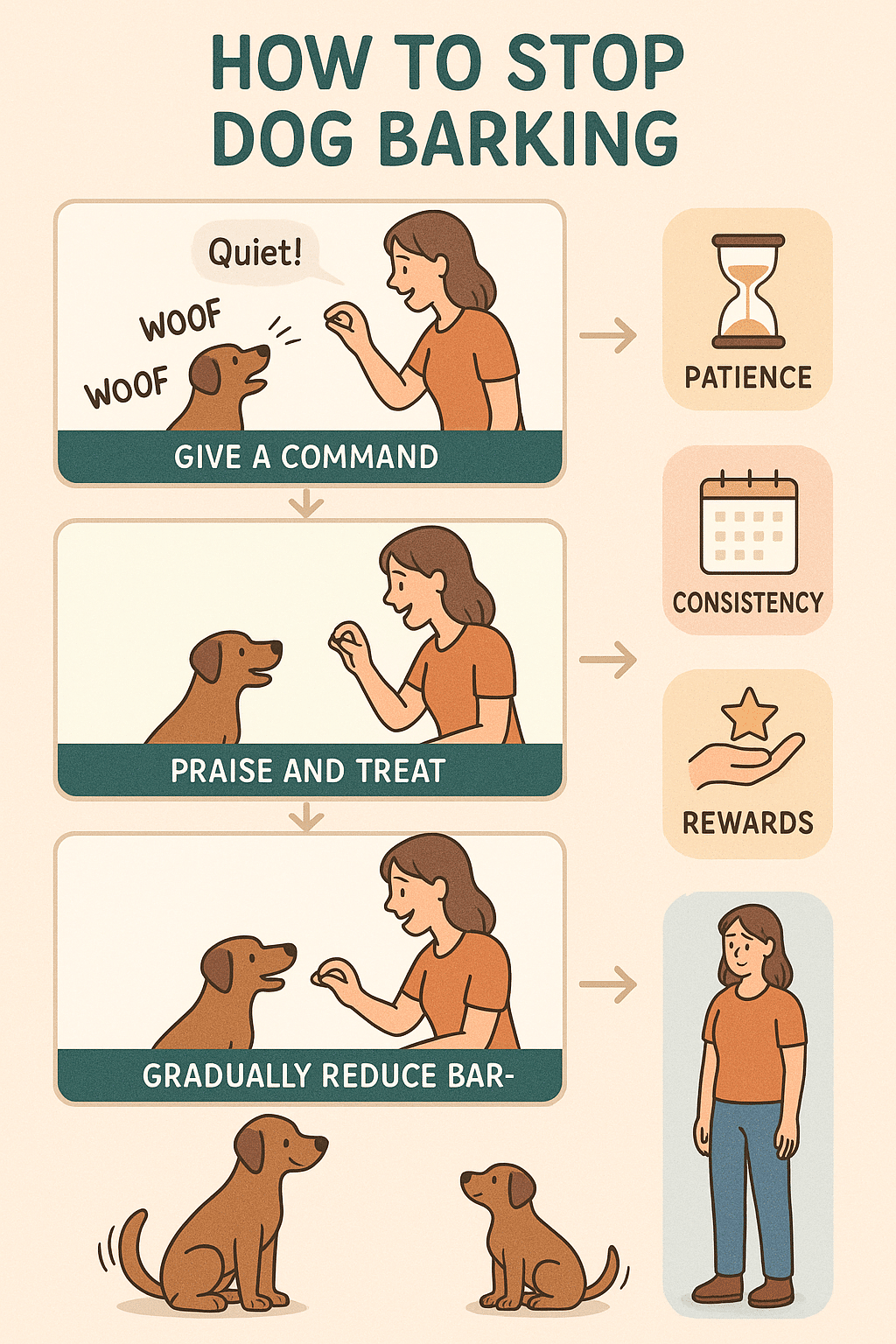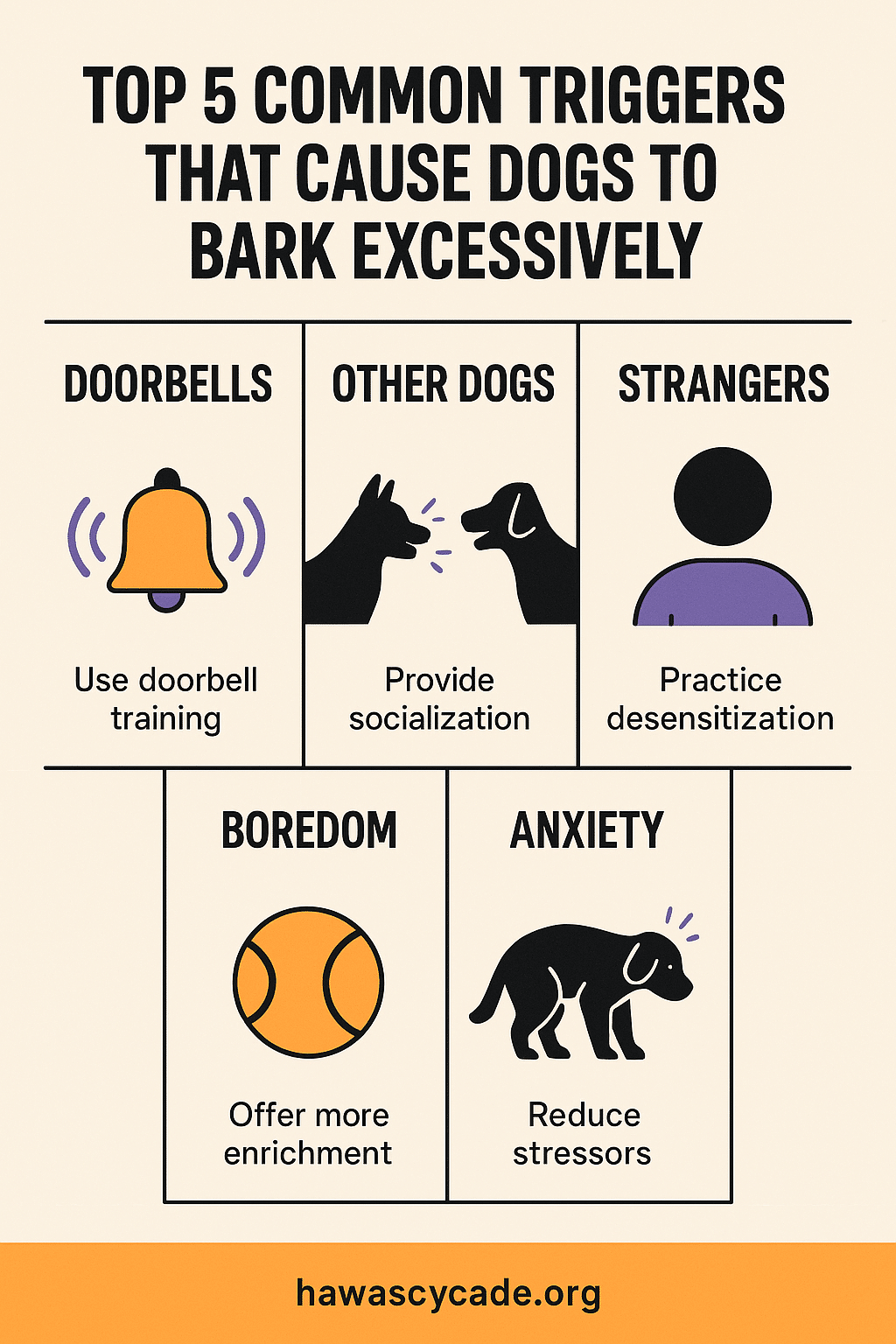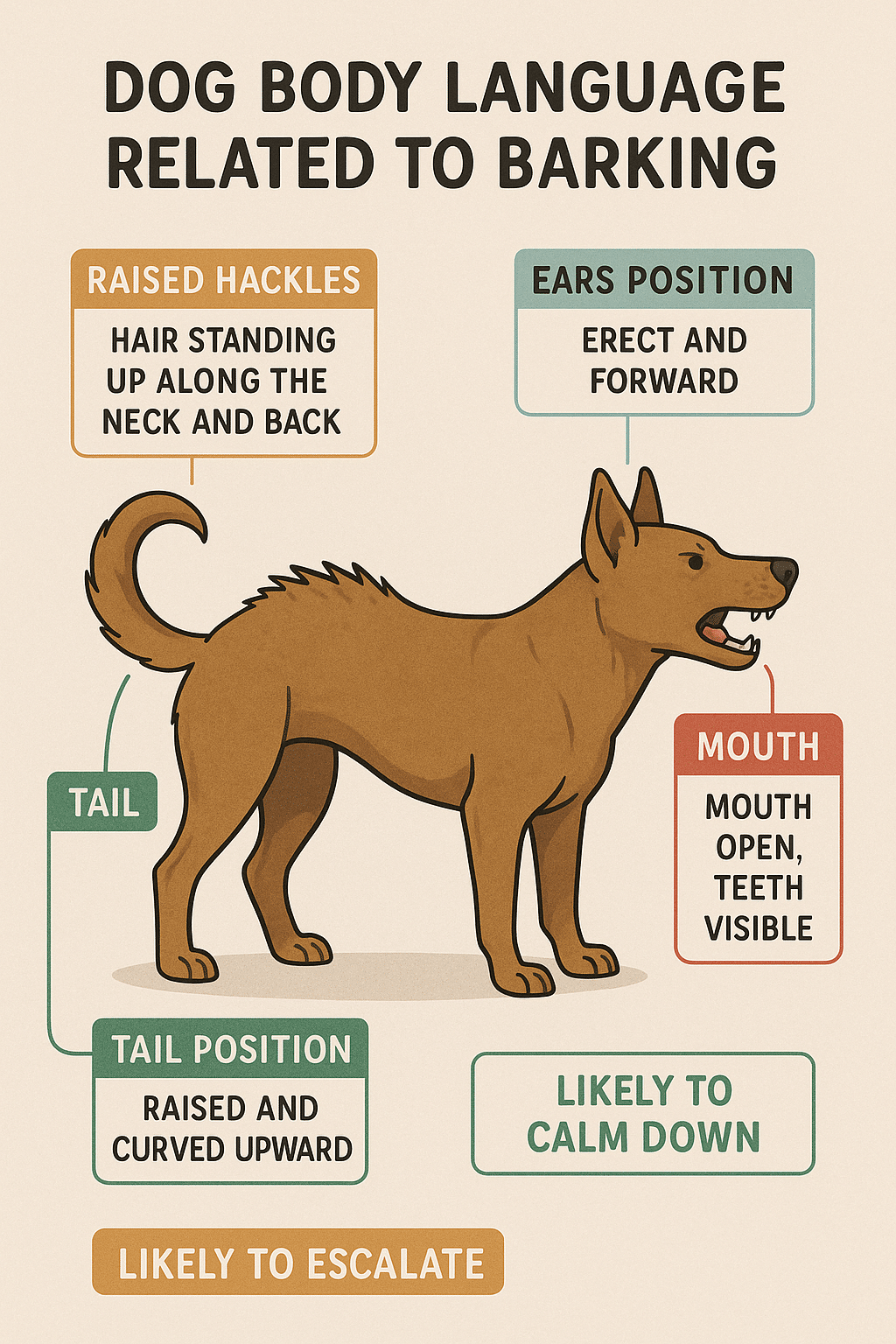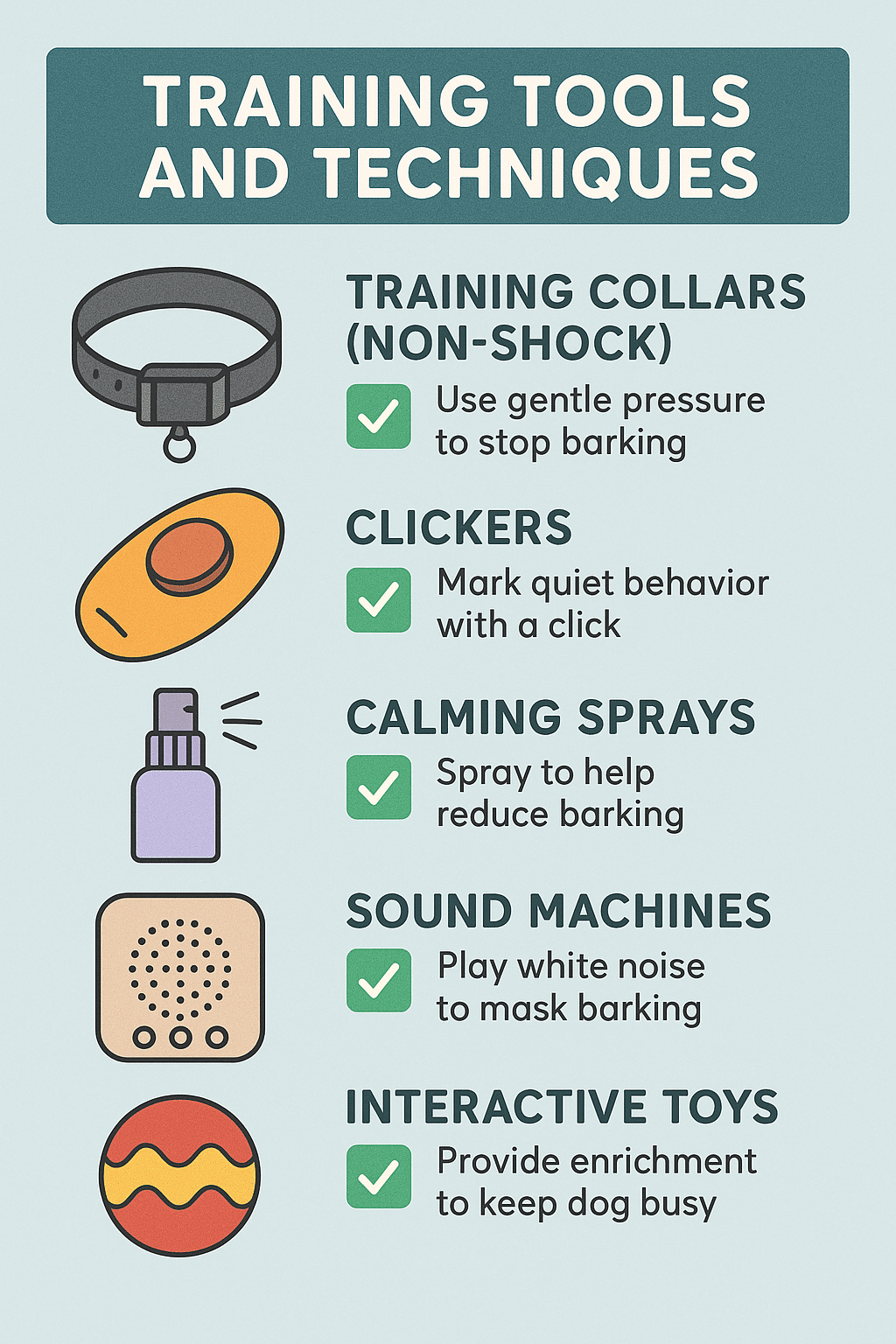Barking is a natural form of communication for dogs, but excessive barking can quickly turn from a harmless quirk into a source of frustration for both pet owners and their families. If you’ve found yourself asking, how to stop dog barking, you’re certainly not alone. Barking issues range from nuisance noises during the night to constant vocal alarms at the doorbell or passersby. Understanding why your furry friend barks excessively is the essential first step before you dive into training methods or behavior modifications.
In this comprehensive guide, I will walk you through five proven ways on how to stop dog barking for good. We’ll explore the reasons behind your dog’s vocal habits, assess triggers specific to various breeds, and dissect training techniques like positive reinforcement and desensitization. You’ll also find expert advice on managing the environment and incorporating mental and physical enrichment tailored to your dog’s needs. Whether you’re dealing with barking triggered by strangers, other dogs, or separation anxiety, this article equips you with practical, detailed strategies to restore peace at home.
Let’s embark on this journey together, turning barking chaos into calm communication.
Understanding Why Dogs Bark: Key Triggers and Behaviors

Barking serves multiple purposes in a dog’s life. It can be a call for attention, an alarm to perceived threats, or simply a symptom of underlying emotions such as loneliness or boredom. To stop excessive barking, you first need to decode its origin.
Common Barking Triggers in Various Dog Breeds
Different breeds have distinct barking tendencies due to their genetics and original functions:
- Terriers (e.g., Jack Russell Terrier, Fox Terrier): Known for their alertness and tenacity, these breeds often bark persistently to alert owners of intruders or unusual stimuli.
- Hounds (e.g., Beagle, Coonhound): Barking is part of their tracking and hunting behavior, often manifesting as howls or baying to communicate with others.
- Guard Dogs (e.g., German Shepherd, Doberman): Vigilant and protective, these dogs are prone to territorial barking when strangers approach the property.
- Toy Breeds (e.g., Chihuahua, Pomeranian): Small dog barkers often bark excessively as a means to compensate for their size, signaling warning or attention-seeking.
Understanding your dog’s breed tendencies helps you predict potential triggers and tailor your approach.
Differentiating Between Barking Types: Alarm, Territorial, and Attention-Seeking
Once you identify the triggers, classifying the barking behavior lays the groundwork for appropriate intervention:
- Alarm Barking: Triggered by sudden noises or unfamiliar sights, alerting owners to what dogs perceive as threats. Example: barking at a doorbell or a stranger in the yard.
- Territorial Barking: This type occurs when a dog guards a space or resource, often escalating when neighbors or other dogs approach.
- Attention-Seeking Barking: Sometimes dogs bark simply to get their owner’s focus, especially if they learn that barking results in play or treats.
Recognizing these differences is critical. For instance, addressing attention-seeking barking involves different techniques than managing territorial barking.
Assessing Your Dog’s Barking: Identifying Underlying Causes

Excessive barking rarely happens in a vacuum. Various emotional and environmental factors play roles in why your dog barks more than desired.
Recognizing Separation Anxiety and Noise Phobias
A dog left alone for long periods may bark incessantly due to separation anxiety. This condition can manifest with destructive behaviors alongside barking. Dogs may panic, yelp, and bark loudly because they feel abandoned or fearful.
Noise phobia, another common cause, is characterized by barking in response to loud or sudden sounds such as fireworks, thunder, or household noises. Dogs susceptible to noise phobia may pace or hide and need gradual conditioning to overcome their fears.
How Boredom and Lack of Mental Stimulation Contribute to Excessive Barking
Dogs are intelligent creatures requiring both physical and mental exercise. Without regular stimulation, they can become restless and use barking as an outlet for pent-up energy or frustration. This is most notable in high-energy breeds like Border Collies or Siberian Huskies.
For example, a dog left in a backyard without toys or exercise might bark at birds, leaves, or simply out of boredom. Understanding the role of mental stimulation is vital in crafting a balanced routine for your dog.
Way 1: Positive Reinforcement to Teach the “Quiet” Command

Positive reinforcement stands as one of the most effective and humane ways to tackle barking problems. This method rewards your dog for good behavior—in this case, remaining quiet on command.
Step-by-Step Guide to Training a Dog to Stop Barking on Command
- Pick a Quiet Trigger: Use a stimulus that causes your dog to bark, such as the doorbell or a knocking sound.
- Wait for Barking to Start: Let your dog bark a couple of times.
- Give the “Quiet” Command: Clearly say “Quiet” in a calm but firm voice.
- Wait for Silence: The moment your dog stops barking, even for a second, immediately praise with treats or affection.
- Repeat Consistently: Sessions should be short but frequent, reinforcing the quiet behavior regularly.
With time, your dog will associate “Quiet” with the reward and learn to stop barking on cue.
Avoiding Unintentional Reinforcement: What Not to Do
One common mistake is inadvertently rewarding barking with attention, even if it’s negative. Yelling at your dog to stop barking can be perceived as attention, encouraging more barking. Similarly, giving treats or cuddles mid-bark reinforces the behavior. Stay neutral and only reward when the dog obeys “Quiet” properly.
Way 2: Desensitization and Counterconditioning Techniques

Desensitization involves slowly exposing your dog to barking triggers at a low intensity, paired with something positive, eventually reducing the dog’s reactive barking over time.
Gradual Exposure to Barking Triggers Like Doorbells and Strangers
Start by playing recorded doorbell sounds at low volume, rewarding your dog for staying calm. Gradually increase the sound’s volume and reintroduce the actual doorbell ringing. Similarly, have a friend approach your home calmly while you reward quiet behavior, shifting your dog’s perception from threat to neutral or positive.
Implementing Noise and Visual Stimulus Desensitization at Home
Using white noise machines or calming music can shield dogs from external noises that trigger barking. Visual barriers like frosted window films or privacy fences limit what dogs see, reducing territorial or alarm barking prompted by visual stimuli.
Way 3: Environmental Management and Routine Establishment
Managing the environment around your dog and instilling routine can drastically reduce excessive barking.
Using Background Noise and Visual Barriers to Limit Barking Opportunities
Many dogs bark at passing pedestrians or vehicles. Solution? Use a white noise machine, radio, or TV to mask outdoor noises. Installing privacy fencing or closing curtains can help reduce visual stimuli that trigger territorial barking.
Creating a Predictable Daily Routine to Reduce Anxiety and Prevent Barking
Dogs thrive on structure. Predictable walks, feeding times, and play sessions create a secure environment, decreasing barking from anxiety or boredom. For instance, setting morning and evening walks helps burn excess energy that otherwise may manifest as barking.
Way 4: Increasing Physical Exercise and Mental Enrichment to Reduce Barking
Burning off excess energy and stimulating your dog’s mind creates a calmer, quieter pet.
Tailoring Activities According to Dog Breeds and Energy Levels
A Border Collie needs intensive, varied exercises like agility training or fetch sessions multiple times daily, whereas a Bulldog may require moderate walks and play. Knowing your breed’s energy requirements helps channel their activity productively.
Interactive Toys and Games That Redirect Attention Away from Barking Triggers
Puzzle feeders, treat-dispensing toys, and sniffing games mentally tire your dog. During times when barking usually spikes, giving your pup an interactive toy can redirect their focus and reduce vocalization.
Way 5: When and How to Seek Professional Help
If barking persists despite your best efforts, it may be time to consult a professional.
Working with Certified Dog Trainers and Canine Behaviorists
Behavior specialists can identify underlying issues such as severe anxiety or deep-rooted territorial instincts. Certified trainers use assessment and personalized plans involving advanced behavior modification techniques to bring long-term calm.
Recognizing Persistent Barking as a Sign for Expert Intervention
If your dog barks incessantly at night, when left alone, or shows signs of distress, expert help ensures you address those deeper problems safely and effectively.
Specialized Solutions for Challenging Barking Scenarios
Certain barking situations require nuanced strategies to achieve success.
How to Stop Dog Barking at Night and During Training Sessions
Night barking often relates to loneliness or anxiety. Solutions include overnight crate training, comforting bedding, or soothing sounds. During training sessions, keep activities short and positive, avoiding frustration-induced barking.
Addressing Barking at Other Dogs, Strangers, and When Alone
Teach your dog to focus on you during walks with commands like “Look” or “Leave it.” For barking when alone, standardized separation anxiety protocols apply: gradual desensitization with increased alone time and calming aids.
Integrating Behavior Modification Techniques Without Yelling or Harsh Methods
Harsh training methods often backfire, increasing stress and barking.
The Importance of Consistency Across All Family Members
Every family member must use the same commands and reinforcement strategies. Mixed signals confuse dogs and prolong barking problems.
Encouraging Incompatible Behaviors to Replace Barking
Teach calm behaviors like “sit” or “go to your mat” that are incompatible with barking and reward them promptly. Redirecting energy prevents barking from becoming the default response.
Case Study Highlights: Successful Long-Term Barking Reduction in Various Breeds
Let’s look at a few real-life successes:
Results from Positive Reinforcement Combined with Environmental Controls
A Beagle suffering from alarm barking at door knocks learned “Quiet” after weeks of positive reinforcement paired with limiting access to the front door area through baby gates. Family consistency was key.
How Breed-Specific Traits Influence Barking and Training Outcomes
A Chihuahua’s attention-seeking barking was managed using interactive toys and structured play periods, while a German Shepherd’s territorial barking required intensive desensitization to neighbors approaching.
Tips and Tools: Technology and Products to Complement Training Efforts
Modern tech can boost your training efforts when used responsibly.
Using Apps, Training Collars, and Monitoring Devices Responsibly
Apps like Pupford or GoodPup offer structured programs on teaching “Quiet” commands. Training collars that emit vibrations or sounds (not shocks) provide reminders to stop barking but must accompany positive reinforcement, never replace it.
When Humane Bark Control Products Can Be Helpful
Ultrasonic devices or citronella collars can discourage barking in extreme cases but should be a last resort and used under guidance to avoid fear or stress.
Maintaining Progress: Strategies for Long-Term Barking Management
Sustaining success requires ongoing effort.
Reinforcing Quiet Behavior and Preventing Relapse with Continued Mental Stimulation
Keep rewarding quiet behavior even after training goals are reached. Regular mental and physical activities prevent boredom-induced barking returning.
Monitoring Behavioral Changes Through Seasonal or Environmental Shifts
Changes such as the arrival of new neighbors, construction noise, or holiday fireworks may trigger barking. Stay vigilant and adjust your strategies accordingly to maintain peace.
Quick Takeaways / Key Points
- Barking serves different purposes: alarm, territorial, or attention-seeking.
- Identify triggers based on breed and environment for targeted training.
- Positive reinforcement is the most effective way to teach “Quiet.”
- Desensitization and counterconditioning reduce reaction to specific stimuli.
- Environmental management and routine reduce anxiety and opportunity to bark.
- Physical exercise and mental enrichment decrease boredom-related barking.
- Professional help is essential when barking stems from severe anxiety or entrenched behaviors.
- Consistency and avoiding yelling ensure stronger, happier training results.
- Technology can support training but should complement—not replace—positive methods.
- Long-term maintenance involves continual reinforcement and adapting to environmental changes.
FAQs
1. How to stop dog barking at night without causing anxiety?
Establish a calming nighttime routine that includes exercise earlier in the day, a comfortable sleep area, and possibly soothing white noise. Avoid harsh corrections as they may increase anxiety and barking.
2. How to stop excessive dog barking naturally?
Natural methods emphasize positive reinforcement, mental stimulation, physical exercise, and environmental modifications without resorting to shock collars or yelling.
3. How to train a dog to stop barking on command?
Use positive reinforcement techniques teaching the “Quiet” command by rewarding your dog for ceasing barking when requested, followed by consistent practice and patience.
4. How to stop dog barking at strangers?
Desensitize your dog by gradually exposing them to strangers with controlled interactions paired with treats, counterconditioning fear or territorial responses into calm behavior.
5. How to stop dog barking when left alone?
Address separation anxiety by building tolerance to alone time slowly, providing engaging toys, and ensuring your dog gets plenty of exercise before being left alone.
Conclusion
Learning how to stop dog barking isn’t about silencing your pet—it’s about fostering healthy communication and a peaceful coexistence. By understanding your dog’s unique reasons for barking, employing positive reinforcement and desensitization, managing their environment, and providing adequate exercise and mental challenges, you set the stage for lasting change. Remember, barking can be significantly reduced, even eliminated in many cases, through consistent, humane training tailored to your pet’s needs.
Don’t hesitate to seek professional guidance if needed, especially for challenging barking rooted in anxiety or behavioral issues. I encourage you to remain patient and committed—your efforts will result in a happier home and a happier dog. Ready to start your training journey? Take the first step today by observing your dog’s triggers and trying the “Quiet” command. Peace and quiet are well within reach!
External links:
– Pupford – Dog training app and resources
– GoodPup – Online dog training with trainers
– American Kennel Club (AKC) – Breed-specific barking information
– Association of Professional Dog Trainers (APDT) – Find certified dog trainers



